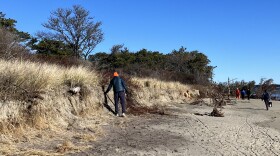A humble but key building block of Connecticut’s ecosystem is in short supply this year: acorns.
According to the Connecticut Agricultural Experiment Station (CAES), more than 80 wildlife species – everything from mice to bears – depend on acorns as a primary food source before and during winter. But an annual survey of hundreds of oak trees by CAES scientists recently found that Connecticut is suffering from a widespread acorn crop failure.
Each year, the state surveys the acorn crop. Past studies have shown that acorn numbers have a ripple effect throughout nature.
One animal particularly impacted is the white-tailed deer. A low acorn crop means deer may wander more in search of something to eat. Scott Williams, head of the CAES Department of Environmental Science and Forestry, said that makes the animals “more vulnerable to collisions with vehicles.”
But he said there are potential positives for people. Low acorn crops mean fewer mice to host ticks. There’s also a potential upside for hunters. Those seeking a deer harvest are more likely to have a successful season when acorn supplies are low because deer can’t hunker down and hide.
When acorn numbers are bountiful, birds of prey like owls and hawks can benefit. That’s because a large acorn supply means the small rodents they hunt have plenty of food to store in their winter dens. Come springtime, those rodents can produce more offspring – yielding more prey opportunities for predatory birds.
Bears are also impacted by acorns. As they prepare for hibernation, bears embark on a power-eating marathon called “hyperphagia,” needing to consume 20,000 calories a day. Acorns – a pound contains roughly 2,000 calories – can go a long way in satisfying that need.
Jenny Dickson, wildlife division director at the state Department of Energy and Environmental Protection, said a shortage of acorns could lead to more bear and human conflicts. “We’re up to 69 home entries for the year right now,” Dickson said. “I wouldn’t be surprised if those numbers go up a little bit more between now and the end of the year.”
What caused the acorn crop failure?
Last year, Connecticut’s oak trees produced a lot of acorns. J.P. Barsky, a CAES research technician, said that as a result, the trees “may not have had enough energy reserves … to produce acorns.” Additionally, oaks have been under stress due to spongy moth caterpillar outbreaks. These invasive insects devour a tree’s leaves early in the growing season. The tree then spends a lot of energy in the summer trying to grow those leaves back.
Barsky said he’s concerned about the long-term future of oak trees in the state. He said there aren’t a lot of oaks making up the new growth in the forest. Instead, it’s a lot of maple, beech and birch trees.
“That’s a very concerning thing,” he said. “Because oaks are a keystone species in our forest.”








